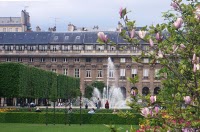Countdown to App Release: Chapter 5 - Royal Hall to Public Mall
 Thursday, July 7, 2011 at 4:15PM Tweet
Thursday, July 7, 2011 at 4:15PM Tweet After hopping over an ocean, soaring through many time zones and communing with several cultures, experiencing sketchy Internet access all along the way, I give you, without further ado, Charlotte's story with an added bonus: One of my favorite images in the entire BMLG App...

In Chapter Five...
In which Louis-Philippe Joseph II, Duc d'Orleans transforms the Palais Royal into the place to be in Paris while aiding the advancement of the coming Revolution...
The gardens of the Palais Royal were for a long time private, enclosed by the backs of houses that faced the outer lying streets. Louis-Philippe Joseph II, Duc d’Orleans, changed that. From 1781-84, he created what you see here: France’s first ever public shopping arcade. He transformed these gardens from a private domain into a popular Parisian social center.
Truth is, the Duc d’Orleans, like his cousin the king, needed money. He was a notorious gambler and he squandered the Orleans family fortune building a private pleasure garden to rival the queen’s hamlet at Versailles. So, he built this new housing and shopping arcade around the perimeter of the Palais Royal gardens, and he did something that had never been done before in France: He sold or rented the apartment spaces to people from all levels of French society, with large apartments for the rich on the first level above the shops, and smaller, more affordable apartments as you reach the roof. He rented the gallery spaces to cafés, smart shops, theatres, restaurants, and even a few gambling casinos.
Louis-Philippe Joseph also encouraged printing presses to open here at the Palais Royal, presses that published and distributed journals and broadsheets expressing the Enlightenment views that were so unpopular with the king. But because this was royal ground prior to the Revolution, the king’s police were not permitted to enter the property. Therefore neither Louis-Philippe nor those who printed revolutionary literature here could be censored under the monarchy. It is thanks to these broadsheets that we in Normandy, and elsewhere in the French provinces, have been made aware of events taking place in the French capital since 1789.
In a few short years Louis-Philippe Joseph II, Duc d’Orleans, turned the Palais Royal into the place to be in Paris. Since their opening, these gardens have been crowded with people both day and night. I read in a popular journal printed right here at the Palais Royal that if you threw an apple from an apartment window it would never hit the ground – that’s how thick the crowd can be!
Café tables and chairs spill out into the gardens at all hours. Circus acts and street performers entertain the crowds. Both Parisians as well as visitors from the Provinces, like myself, come to the Palais Royal to shop, gamble, drink, and mingle, because this is the place to meet and discuss the ideas of Enlightenment philosophy. And where, in 1789, it was very fashionable to talk of Revolution.
That’s why it is said that the French Revolution started right here, at the Palais Royal!
Come back for Chapter Six...
In which Charlotte explains the meaning of "Revolution".
Image:
The Palais Royal Garden, 18th C. From Paul Lacroix Jacob (1806-1884), The XVIIIth century: its institutions, customs, and costumes: France, 1700-1789; illustrated with 21 chromolithographs and 351 wood engravings after Watteau, et al. London: Chapman and Hall, London, 1876. Digital image of color plate opposite page 346, courtesy of The Costumer’s Manifesto, http://www.costumes.org.
 Post a Comment | |
Post a Comment | |  Email Article |
Email Article |  Print Article | tagged
Print Article | tagged  Beware Madame La Guillotine,
Beware Madame La Guillotine,  Palais Royal,
Palais Royal,  Palais Royal Gardens | in
Palais Royal Gardens | in  French History,
French History,  TTT Tales |
TTT Tales |  Permalink
Permalink 









